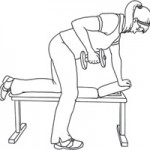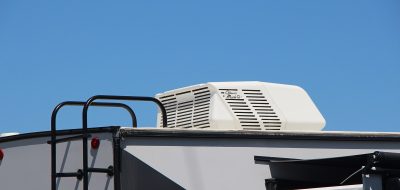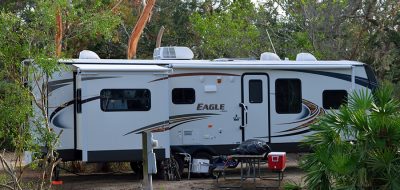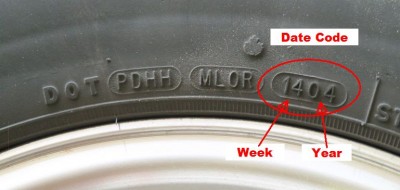AIR CONDITIONING:
1. Your Air Conditioner is designed for a 20 degree temperature drop. If it is 100 degrees outside, the best your air conditioner can do is 80 F degree in the best of circumstances.
2. Clean your air filters weekly, or sooner if needed.
3. Annually perform the needed preventive maintenance, clean the coils under the outside cover and other items listed in your owner’s manual.
4. Pull down your shades, and add insulation to your windows when necessary.
5. Park in the shade – but examine the trees and structures for possible wind damage before doing so.
6. A water mister may be attached to your awning, or awning rail in low humidity climates to help keep your RV cool. A timer could be added, maybe 9am to 7pm to save water. Use a water filter if the water is hard.
7. Go on a day trip, to the mall, the movies or to the swimming pool on a HOT day.
8. Monitor your AC voltage, the minimum is 107 volts, the maximum is 130 volts.
9. Close or block off living areas not needed. Retract slides to minimize the space needed to air condition.
10. Pay close attention to your pets. Do they have water at all times, and can they retreat to the cooler floor areas?
11. Avoid the steam and warmth of cooking inside on a hot day. Cook outdoors or in the earliest and latest part of the day.
12. Dress in light colored clothing; sit under the shade and enjoy your new location.
RV101byfred.com
Fred Brandeberry, President






Pingback: url
Pingback: site
Pingback: my homepage
Pingback: my url
Tim
I have a 1988 Winnebago with roof top “Coleman Quiet” A/C. My problem?
Condensation is flowing accross the top and down the side. Also, it started to come in fron the ceiling. I have taken the shroud off and cleaned the coils plus sprayed any debris “Mud from Wasp” and leaves. It still comes in and over the top. Is there a dranage tube that I did not see? Please tell me what I can do.
Thank you ! Sincerely, Tim
Robert F Cyphers
Today’s Roof type AC units geneally have 25 to 30 degrees F difference between supply and discharge temp. Latent heat, humidity, is the first heat source removed. After the humidity falls the temperature will begin to fall. If water is sprayed on the outside coil, the hot coil when cooling, it will increase the efficiency of the unit and will result in more cooling capacity. If the filter is kept clean the condensate will usually wash the cooling coil during use. If in a dusty area the outside coil should we cleaned often. This can be done by sparying the outside coil with a liquid detergent, letting it soak in for a while and then washing it until the water comming out of the unit is clean. The sum of the previous comments in general are correct. Start, Run and Hard Start capacitors seldom fail and need no maintenance. Replace them when they fail. Fan motors probably have the higest failure rate in these units.
Thomas Becher
The single most important thing to do is keep you air filters clean: Some those foamy types (look like a chore girl) are next to useless. They operate on the principal of static and allow too much air to pass thru. If your evaporator gets dirty, the crud stays on the coils because of the condenstation and you will have to pay someone to clean it. If it’s a rooftop unit it probably would have to be removed from the rv for cleaning. Don’t forget the condensor (the outside part of the AC) it too have fins that get dirty but doesn’t have a filter. Usually if it’s a rooftop unit it stays pretty clean but if you have cottonwood nearby it can spell trouble. I used to make a living cleaning AC’s during the summer. You could put a window screen over the condenser( Check Air flow) and clean DAILY
Jerry Shea
Talk about a AC surprise. My freeze switches did not work and had to be replaced. When they pulled the unit (sub basement type) the air inlet from the coach and evaperator coil was clogged with over a 1/2 inch of dirt and hard dryed ?. While I change the filter ofter, I purchased a 2 year old coach. This build up was close to a six year period. Going forward I will have it serviced every 2 years.
Richard Schultz
Ah GMAs, I think I liked your first post the best, the second one seemed (to me at least) confusing. That being said, all Fred’s points beyond #1 & 6 are dead on. Number six btw is a sensory thing, evaporation only changes what you feel so it may feel cooler around the rv but the total heat content doesn’t change one iota. And in that light, the one single largest heat load in any ac system is moisture removal, the latent heat (hidden heat) required for a change of state (ie water to vapor or vice versa) is immense.
GMAs
I think a lot of people don’t understand the physics of cooling a RV…
In physics you were taught that a BTU is a unit of thermal energy…
Well not to get deep.. into physics and thermal… here is why you can’t get the RV cooler when its hot outside… and its not the AC unit…
The AC unit puts out .. oh say 13,000 btu of cool air… now this is the air differance between the input and output of the cold side of the thing…
As the temp in the RV starts to pull down. get colder… the temp differential from the outside to the inside of the RV …then starts putting a higher demand by absorption of the AC BTU for each degree you are trying to make it colder inside with. thus basically as you get to the equal point of where your AC is still pulling down the 13,000 your unit (RV) is now absorbing it through the insulation.. fraim, etc… and thus the inside temp is now not going down any more.. so the AC is still putting out its 13,000 negative (so to speak) BTUs and cooling the air coming into it down.. but the air then that is returned to the RV is being heated by the fact that the outside differential is hotter and thus soaking through the RV’s insulation heating the air inside… which now is at a balance point and thus the inside of the RV will only cool so much…
Think of it this way too… you have a 13,000 negative BTU AC… but you have a 35,000 btu heater… which one do you think will keep the insides better… When its cold outside.. and you warm inside…. you have only reversed the equasion on the RV… thus when its 30 outside.. you need 25,000 btu to keep the inside at 68 deg F… thus when its 68 outside… and you want it 30 deg inside.. you unit will have to have the same 25,000 but to make it happen… sort of a balance act… but, like the heater in the winter.. its not instantanious… neither is the cooling of the inside to the outside… as you have a mass of fixtures and items that also need to change energy states…
So next time when you think the AC is not cooling like it should.. or as quickly.. you need to remember the balance of energy… its all reliative… so to speak…
GMAs
LOL… Chris is right… its the diff between the return and outgoing air.. . right up to the point where you turn the box into a refrigrator… grin… Once frozen… it ices up…and no air gets through then…
As to protecting the a/c start cap… when it goes out.. replace it.. The start cap is their to change the phase of the current so the motor gets a boost in torque when it starts up.. once running it phase locks on the line frequency… well its supposed to in theroy… I guess one could try and keep it cool to help give it longer life.. but, most are paper/oil units that really don’t go out that often… more its when the compressor/motor starts to get old.. they let you know it… then again as they get old they don’t make the same high pressure and the cooling effecency falls off before the start cap lets go… and instead of cooling.. the motor adds its wattage to the mix and now you start heating instead of cooling…
I find that keeping the AC unit out of the sun /exposure.. helps.. but with that being said… roof top ones allow a better circulation of air.. and thus will work just as good as the bottom unit…
Also… I saw a unit where they put a water evap cooler along with the refrigration unit.. ahhh not a good idea.. as one adds water to the air… the other.. take ith it out… adding to its loading… but, you do get cold water out the drain.. grin..
To get better results from the AC.. especally for AS trailers because they are alu… if one can find a shelter to park under… (shade) its like having two AC units while your only paying for one… dramatic differance.
all the suggestions above are very good ones… Fred did his homework and has lots of experance to draw from… might want to make a print out of them and put ’em on the locker wall… as a sort of … checklist for keeping cool…
outstanding suggestions Fred…..
Paul Hawes
Having struggled with an A/C problem for over one year, I have now done a lot of research. Several A/C technicians have explained to me that the 20 degrees is the difference between the input and the output temperature. That makes sense. Thus, I agree with Chris Bryant’s comment. The amount that you can cool depends upon the quality of your coach’s insulation. The idea that you cannot cool below 20 degrees outside temperature seem a common misconception. I certainly have heard it often.
Bob Vaughn
When I went to A/C school they taught us that the 20 degree drop was from the input to the output side of the evaporator coil Yes Chris that is the same thing I was taught…
Richard Schultz
Your tips about parking in the shade etc are exactly right, it will help cool your rv down by reducing the about of radiated heat being absorbed by the walls etc. On the other hand the 20 degree temp difference refers to the drop across the evaporator coil which is dealing with strictly indoor air and is independent on the outside air temp. Bottom line is if your ac is rated around 15,000 btu/hr and you exceed that because of outside air temp, exposure to direct sunlight, indoor activities such as cooking, bathing etc and or high humidity you’re gonna get hot. At night as the sun goes down most rv air conditioners will do the job regardless of the outside temp.
da78
Thanks for the tips. I also installed on my coach window film. Still can see what going on outside while keeping cool.
Chris Bryant
The 20 degree temperature drop is between the return air and supply air- not between the inside and outside temperatures.
A properly sized A/C unit on a well insulated rig can and will drop the inside temperature to whatever you set the thermostat to.
bob
What is the best way to protect the a/c start capacitor?
Thomas C Glenn
what is the better unit ?a roof top or a basement type unit?
mr_whit
thank you Fred, I did not know about the 20 degrees or bringing in the slide-whit